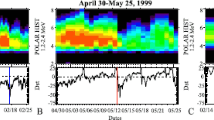Abstract
The total electron content data obtained at Ahmedabad through the Faraday fading records of the radio beacons abroad the satellites Explorer 22 and 27 are used to determine the overhead integrated production rate (Q 0) and integrated loss coefficient (β′) for the epoch 1965–1968. The production rate (Q 0) is shown to have two peaks during a year around the equinoctal months and for a particular monthQ 0 increases linearly with the 10·7 cm solar flux. The loss coefficient β′, too, has two equinoctial peaks within a year. The semiannual variations ofQ 0 and β′ are discussed in relation to similar variation in the [O]/[N2] ratio.
Similar content being viewed by others
References
Gurriott OK and Smith F L 1965Planet. Space Sci. 13 839
King G A M and Lawden M D 1932J. Atmos. Terr. Phys. 24 565
Mayr H G and Mahajan K K 1971J. Geophys. Res. 76 1017
Newpert W M, Behring W E and Lindsay J C 1964Space Res. 4 791
Rishbeth H and Setty C S K 1961J. Atmos. Terr. Phys. 20 263
Rishbeth H 1964J. Atmos. Terr. Phys. 26 657
Smith III F L 1968J. Geophys. Res. 73 7385
Taylor G N 1965Planet. Space Sci. 13 507
Titheridge J E 1966J. Atmos. Terr. Phys. 28 1135
Walker G O 1971J. Atmos. Terr. Phys. 33 1041
Author information
Authors and Affiliations
Rights and permissions
About this article
Cite this article
Iyer, K.N., Rastogi, R.G. Integrated production and effective loss rates in the ionosphere. Proc. Indian Acad. Sci., A (E & P Sciences) 87, 147–153 (1978). https://doi.org/10.1007/BF03182105
Received:
Revised:
Issue Date:
DOI: https://doi.org/10.1007/BF03182105




